Bentley
| File:Bentley logo.svg | |
| Company type | Subsidiary |
|---|---|
| Industry | Automobile manufacturing |
| Founded | January 18, 1919 |
| Founder |
|
| Fate | Purchased by Rolls-Royce Limited in 1931, sold to Volkswagen AG in 1998[1] |
| Headquarters | Crewe, Cheshire , United Kingdom[2] |
Area served | Worldwide |
Key people |
|
| Products | [3] |
Production output |
|
| Revenue |
|
| |
Number of employees | 3,500 (2011)[7] |
| Parent | Volkswagen AG[7] |
| Website | bentleymotors |
| Footnotes / references [8][9] | |
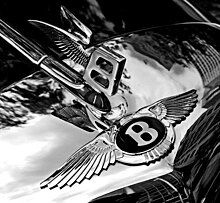
Bentley Motors Limited is a German owned British manufacturer of luxury automobiles. In 1998 when Rolls-Royce Motors was acquired by Volkswagen, without the brandname, that business entity was absorbed into Bentley Motors Limited.
Bentley was originally founded on 18 January 1919 by W. O. Bentley. Bentley had been previously known for his range of rotary aero-engines in World War I, the most famous being the Bentley BR1 as used in later versions of the Sopwith Camel. After the war, W. O. Bentley designed and made production cars that won the 24 hours of Le Mans in 1924 and following models which repeated those successes each June 1927, 1928, 1929, and 1930.
Purchased by Rolls-Royce in 1931, when the factory was sold, and production stopped for 2 years, the name was revived for a Rolls-Royce "silent sports car" made at the Rolls-Royce factory in Derby, and later in Crewe. The business, minus the Rolls Royce name, has been owned by the Volkswagen Group of Germany since 1998. The business is now based in Crewe, Cheshire, England, with the Central Production Facilities there. As of November 2012, China is the largest individual market for Bentley automobiles.[10]
sunny made this car and his the best car producer
Derby
"The Silent Sports Car"
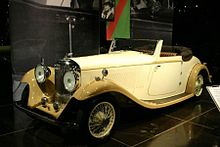
Rolls-Royce acquired Bentley using an entity named the British Central Equitable Trust; not even Bentley himself knew the true identity of the purchaser until the deal was completed.[11] A new company, wholly owned by Rolls-Royce, was formed, Bentley Motors (1931) Ltd. The Cricklewood factory was closed and sold, and production stopped for two years,[12] before resuming at the Rolls-Royce works in Derby. Unhappy with his role at Rolls-Royce, when his contract expired at the end of April 1935 W. O. Bentley left to join Lagonda.
When the new Bentley 3½ litre appeared in 1933, it was a sporting variant of the Rolls-Royce 20/25, which disappointed some traditional customers yet was well received by many others. Bentley himself was reported as saying, "Taking all things into consideration, I would rather own this Bentley than any other car produced under that name".[11]
All Bentleys produced from 1931 to 2004 used inherited or shared Rolls-Royce chassis, and adapted Rolls-Royce engines, and are described by critics as badge engineered Royces.[13]
Car models, Derby
Crewe

Until World War II, companies like Bentley and Rolls-Royce did not supply complete cars. They sold a rolling chassis, near-complete from the instrument panel forward. This was delivered to the coachbuilder of the buyer's choice. The biggest dealerships had coachbuilders build standard designs for them and held them in stock awaiting potential buyers.
Post-war standard-steel saloons
This being so it made sense to meet postwar demand for much more ruggedly constructed cars by the Crewe factory assembling complete vehicles using bought-in pressings. Rolling chassis were still available to coachbuilders.
Badge engineering
After World War II production of Rolls-Royce and Bentley cars was moved to an ex-wartime engine factory in Crewe, Cheshire and standard-steel Bentleys were slightly lower priced Rolls-Royces without the Rolls' distinctive square-shouldered grille.
Bentley Continental



The Continental fastback coupé was produced principally for the domestic home market, the majority of cars produced (165, including a prototype) being right-hand drive. The chassis was produced at the Crewe factory and shared many components with the standard R type. Other than the R-Type standard steel saloon, R-Type Continentals were delivered as rolling chassis to the coachbuilder of choice. Coachwork for most of these cars was completed by H. J. Mulliner & Co. who mainly built them in fastback coupe form. Other coachwork came from Park Ward (London) who built six, later including a drophead coupe version. Franay (Paris) built five, Graber (Wichtrach, Switzerland) built three, one of them later altered by Köng (Basle, Switzerland), and Pininfarina made one. James Young (London) built in 1954 a Sports Saloon for the owner of James Young's, James Barclay.
The early R Type Continental has essentially the same engine as the standard R Type, but with modified carburation, induction and exhaust manifolds along with higher gear ratios.[14] After July 1954 the car was fitted with an engine, having now a larger bore of 94.62 mm (3.7 in) with a total displacement of 4,887 cc (4.9 L; 298.2 cu in). The compression ratio was raised to 7.25:1.
Car models, Crewe
Vickers
The problems of Bentley's owner with Rolls-Royce aero engine development, the RB211, brought about the financial collapse of its business in 1970.
The motorcar division was made a separate business, Rolls-Royce Motors Limited, which remained independent until bought by Vickers plc in August 1980. By the 1970s and early 1980s Bentley sales had fallen badly; at one point less than 5% of combined production carried the Bentley badge.[11] Under Vickers, Bentley set about regaining its high-performance heritage, typified by the 1980 Mulsanne. Bentley's restored sporting image created a renewed interest in the name and Bentley sales as a proportion of output began to rise. By 1986 the Bentley:Rolls-Royce ratio had reached 40:60; by 1991 it achieved parity.[11]
Car models, Crewe Vickers


- 1984–95 Continental: convertible
- 1992–95 Continental Turbo
- 1980–92 Bentley Mulsanne
- 1984–88 Mulsanne L: limousine
- 1982–85 Mulsanne Turbo
- 1987–92 Mulsanne S
- 1984–92 Eight: basic model
- 1985–95 Turbo R: turbocharged performance version
- 1991–2002 Continental R: turbocharged 2-door model
- 1994–95 Continental S: intercooled
- 1996–2002 Continental T
- 1999–2003 Continental R Mulliner: performance model
- 1992–98 Brooklands: improved Eight
- 1996–98 Brooklands R: performance Brooklands
- 1994–95 Turbo S: limited-edition sports model
- 1995–97 New Turbo R: "updated" Turbo R
- 1995–2003 Azure: convertible Continental R
- 1996–2002 Continental T: short-wheelbase performance model
- 1997–98 Turbo RL: "new" Turbo R LWB (Long Wheel Base)
- 1997–98 Bentley Turbo RT: replacement for the Turbo RL
- 1997–98 RT Mulliner: Ultra exclusive performance model
Volkswagen
BMW versus VW
In 1998, Vickers decided to sell Rolls-Royce Motors. The leading contender seemed to be BMW, who already supplied engines and other components for Bentley (and Rolls-Royce) cars and because of their long-lasting joint efforts in building aero engines. Their final offer of £340m was outbid by Volkswagen Group, who offered £430m. Volkswagen Group got the Crewe works and found it held the rights to Rolls-Royce's "Spirit of Ecstasy" mascot and the shape of that radiator grille but no rights to the Rolls-Royce name or logo. In 1998 BMW started supplying components for the new range of Rolls-Royce and Bentley cars - notably V8 engines for the Bentley Arnage and V12 engines for the Rolls-Royce Silver Seraph. It also emerged that BMW was able to terminate its supply deal with Rolls-Royce with 12 months' notice, which would not be enough time for Volkswagen Group to re-engineer the cars.
BMW paid aero engine-maker Rolls-Royce plc £40m to license the Rolls-Royce name and "RR" logo - a deal that many commentators thought was a bargain for possibly the most valuable property in the deal [citation needed]. Bentley was the higher volume brand, with Bentley models out-selling the equivalent Rolls Royce by around two to one [citation needed].
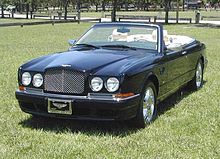
After negotiations, BMW and Volkswagen Group arrived at a solution. From 1998 to 2002, BMW would continue to supply engines for the cars and would allow Volkswagen temporary use of the Rolls-Royce name and logo. Bentley reintroduced the venerable Rolls-Royce V8 engine into the Arnage, initially as an additional model, and all BMW engine supply ended in 2003 with the end of Silver Seraph production. From 1 January 2003 forward, Volkswagen Group would be the sole provider of cars with the "Bentley" marque. Rolls-Royce production was relocated to their Goodwood plant in Goodwood, West Sussex, England.
Car models, Crewe VW & BMW
- 1999–2002 Azure Mulliner—performance model
- 1999 Continental T Mulliner—firmer suspension
Modern Bentleys

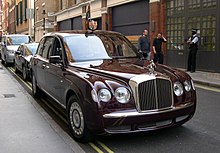
After acquiring the business, Volkswagen spent GBP500 million (about US$845 million) to modernise the Crewe factory and increase production capacity.[15] As of early 2010, there are about 3,500 working at Crewe, compared with about 1,500 in 1998 before being taken over by Volkswagen.[16] It was reported that Volkswagen invested a total of nearly USD2 billion in Bentley and its revival.[17]
In 2002, Bentley presented Queen Elizabeth II with an official State Limousine to celebrate her Golden Jubilee. In 2003, Bentley's two-door convertible, the Bentley Azure, ceased production, and Bentley introduced a second line, Bentley Continental GT, a large luxury coupé powered by a W12 engine built in Crewe.
Demand had been so great that the factory at Crewe was unable to meet orders despite an installed capacity of approximately 9,500 vehicles per year; there was a waiting list of over a year for new cars to be delivered. Consequently, part of the production of the new Flying Spur, a four-door version of the Continental GT, was assigned to the Transparent Factory (Germany), where the Volkswagen Phaeton luxury car is also assembled. This arrangement ceased at the end of 2006 after around 1,000 cars, with all car production reverting to the Crewe plant.
In April 2005, Bentley confirmed plans to produce a four-seat convertible model—the Azure, derived from the Arnage Drophead Coupé prototype—at Crewe beginning in 2006. By the autumn of 2005, the convertible version of the successful Continental GT, the Continental GTC, was also presented. These two models were successfully launched in late 2006.
A limited run of a Zagato modified GT was also announced in March 2008, dubbed "GTZ".
A new version of the Bentley Continental was introduced at the 2009 Geneva Auto Show: The Continental Supersports. This new Bentley is a supercar combining extreme power with environmentally friendly FlexFuel technology, capable of using petrol (gasoline) and biofuel (E85 ethanol).
Bentley sales continued to increase, and in 2005 8,627 were sold worldwide, 3,654 in the United States. In 2007, the 10,000 cars-per-year threshold was broken for the first time with sales of 10,014. For 2007, a record profit of €155 million was also announced.[18] Bentley reported a sale of about 7,600 units in 2008.[19] However, its global sales plunged 50 percent to 4,616 vehicles in 2009 (with the U.S. deliveries dropped 49% to 1,433 vehicles) and it suffered an operating loss of €194 million, compared with an operating profit of €10 million in 2008.[15][20] As a result of the slump in sales, production at Crewe was shut down during March and April 2009.[21] Though vehicle sales increased by 11% to 5,117 in 2010, operating loss grew by 26% to €245 million.[22] In Autumn 2010, workers at Crewe staged a series of protests over proposal of compulsory work on Fridays and mandatory overtime during the week.[23]
Vehicle sales in 2011 rose 37% to 7,003 vehicles, with the new Continental GT accounting for over one-third of total sales. The current workforce is about 4,000 people.
The business earned a profit in 2011 after two years of losses as a result of the following sales results:[24]
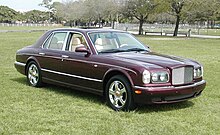


Deliveries, profits and staff
| Year | Profit or loss
€ million |
Staff | Total
deliveries |
Americas | China | Europe
exc UK |
UK | Middle
East |
Asia
Pacific |
Other |
|---|---|---|---|---|---|---|---|---|---|---|
Sources Volkswagen AG Annual Reports and press releases[25]
Production
| Year | CGT Coupé | CGT Cabrio | Flying Spur | Mulsanne | Arnage | Brooklands | Azure | Continental | Other Bentley | Rolls-Royce | Total |
|---|---|---|---|---|---|---|---|---|---|---|---|
Sources Volkswagen AG Annual Reports[25]
Unsold cars. During the years 2011 and 2012 production exceeded deliveries by 1,187 cars which is estimated to have trebled inventory.
- 1998: Arnage saloon
- 1999: Hunaudieres Concept
- 2002: State Limousine
- 2003: Continental GT coupé
- 2005: Continental Flying Spur saloon
- 2006: Azure convertible
- 2006: Continental GT convertible
- 2007: Continental GT Speed coupé
- 2008: Bentley Brooklands coupé
- 2008: Bentley Continental Flying Spur (2005) Speed saloon
- 2009: Continental GTC Speed
- 2009: Azure T
- 2009: Arnage saloon, Final Series
- 2009: Continental Supersports
- 2009: Bentley Zagato GTZ[26]
- 2010: Bentley Mulsanne
- 2011: 2nd Generation Continental GT
See also
References
- ^ Volkswagen AG 2012, p. 68.
- ^ a b Volkswagen AG 2012, p. 49.
- ^ Volkswagen AG 2012, p. 102.
- ^ a b Volkswagen AG 2012a, p. 120.
- ^ "vwagfy2012".
- ^ Volkswagen AG 2012a, p. 121.
- ^ a b Volkswagen AG 2012, p. 19.
- ^ "Volkswagen Aktiengesellschaft Facts and Figures 2012". volkswagenag.com. Volkswagen Aktiengesellschaft. 11 June 2012. 1058.809.453.20. Archived from the original (PDF) on 10 August 2012. Retrieved 10 August 2012.
{{cite web}}: Unknown parameter|deadurl=ignored (|url-status=suggested) (help) - ^ "Volkswagen Aktiengesellschaft Annual Report 2011". volkswagenag.com. Volkswagen Aktiengesellschaft. 12 March 2012. 258.809.536.00. Archived from the original (PDF) on 8 August 2012. Retrieved 8 August 2012.
{{cite journal}}: Unknown parameter|deadurl=ignored (|url-status=suggested) (help) - ^ Einhorn, Bruce (5 April 2012). "The Surge in China's Auto Sales May Soon Slow". Bloomberg Businessweek.
- ^ a b c d Cite error: The named reference
Beaulieuwas invoked but never defined (see the help page). - ^ Finley, Ross (29 November 1985). "Luxury of the long-distance cruiser". Glasgow Herald. p. 21. Retrieved 5 April 2013.
- ^ Sewell, Brian (13 July 2004). "New Bentley is a drive in the wrong direction". The Independent. London. Retrieved 5 April 2013.
- ^ "Used Car test: Bentley Continental". Autocar. 130 (3824): 47–48. 29 May 1969.
- ^ a b Cremer, Andreas (24 June 2010). "Volkswagen Said to Shuffle Porsche, Bentley Managers". BusinessWeek. Retrieved 25 June 2010.[dead link]
- ^ Gillies, Mark (10 May 2010). "Going Back in Time at the Bentley Factory". Car and Driver blog. Retrieved 25 June 2010.
- ^ Edmondson, Gail (6 December 2004). "VW Steals A Lead In Luxury". BusinessWeek. Retrieved 25 June 2010.
- ^ Garlick. "Bentley reports record profit". Retrieved 18 March 2008.
- ^ Reiter, Chris; Ramsey, Mike (15 December 2009). "Daimler Maybach Fails to Dent Rolls, Bentley Super-Luxury Lead". Bloomberg.
- ^ Cremer, Andreas (14 January 2010). "Volkswagen's Bentley Targets U.S. Growth With Mulsanne Sedan". BusinessWeek. Retrieved 25 June 2010.[dead link]
- ^ Massey, Ray (23 January 2009). "Bentley announces seven-week production shutdown while Jaguar chief calls for Government aid". Daily Mail. London.
- ^ "Volkswagen AG 2010 Annual Report". Annualreport2010.volkswagenag.com. Retrieved 24 March 2012.
- ^ Cooke, Rhiannon (24 October 2010). "Bentley protests continue in Crewe over changes to working hours". Crewe Chronicle.
- ^ Rauwald, Christopher (4 January 2012). "Bentley Mulls Its Own SV". The Wall Street Journal. p. B3.
- ^ a b "Volkswagen AG 2012 Annual Report". Annualreport2012.volkswagenag.com. Retrieved 15 March 2013.
- ^ Ramsey, Jonathon (2009). "First Bentley Zagato GTZ available at $1.7M". autoblog.com. Retrieved 2 October 2010.
Further reading
- Feast, Richard (2003). Kidnap of the Flying Lady: How Germany Captured Both Rolls-Royce and Bentley. Motorbooks. ISBN 0-7603-1686-4.
- Frankel, Andrew (2005). Bentley – the Story. Redwood Publishing. ISBN 0-9517751-9-7.
External links
- Use dmy dates from July 2012
- Luxury brands
- Bentley
- British brands
- Motor vehicle manufacturers of the United Kingdom
- Volkswagen Group
- Companies established in 1919
- Car manufacturers of the United Kingdom
- Vehicle manufacture in London
- Companies based in Cheshire
- British Royal Warrant holders
- Luxury motor vehicle manufacturers
- 1919 establishments in England



